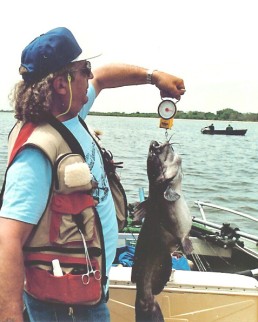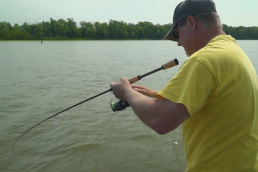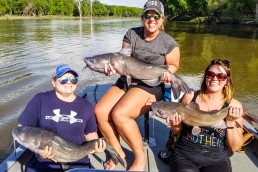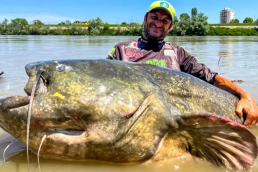Illinois Catfish Lakes
SHARE THIS POST
Except for the large reservoirs of Shelbyville, Rend and Carlyle, most of the lakes in the state are on or border state-controlled land. The reservoirs are on dammed river systems. A few power plant cooling lakes fit into both categories.
Governor Bond Lake near Greenville is typical of the impoundments popular with non-river anglers. It has 775 acres of surface area and 24-miles of shoreline. It contains a variety of wood cover and underwater structures. Both boat and shore fishers use this lake. The city requires a permit for boat access with a 120-horsepower limit on engines. The boat ramp is at the east end of the dam and has ample parking as well as picnic facilities. Limited boats slips and campsites are available at the marina on the southwest end of the lake.
IDNR surveys found channel catfish average four pounds with a length of 14 to 47 inches. There is no creel or length limit.
Many catfish anglers on Bond Lake like to drift fish. They motor up to the windward side of the lake and then drift over some of the 5-foot-deep flats with a live shad hooked from the tail to the back. When the catfish attacks the bait from the head, the hook is in a perfect position to impale it.
Josh Adkins of Greenville, Ill. regularly fishes this lake from either a boat or on shore. He reports that he divides his time fishing 50/50 between the two types of fishing.
Josh prefers to fish for flatheads in the dusky hours. He looks for timber, either upright or fallen. Adkins casts to it and waits 10 to 15 minutes for a bite. If none is forthcoming, he moves to another spot and repeats his actions.
Josh catches bluegills himself for bait; they are his preference four out of five times. He prefers live ‘gills about 7 to 9 inches in length. Josh rigs them on a standard catfish rig with a 1/2-ounce sinker about 2 feet above a 2/0 hook. Impale the hook in the bluegill just in front of the dorsal fin. The sinker stays on the bottom of the lake and the bluegill swims in circles around it. With this rig, Josh has taken some 50-pound flatheads from Governor Bond Lake.
Fishers cannot legally purchase bluegills for bait in this state. But you can catch your own.
The same rig for channel catfish works for both flatheads and channels. But Josh finds either fresh or frozen shad better with channels. Most of the channels he catches are in the 2- to 4-pound range. He follows his regular pattern, and like the drift fishers, he particularly likes windswept rocks and flats about 3 to 6 feet in depth.
Adkins’ advice to lake and river anglers is to pick an area and get to know it. Experimentation and study are keys. He stresses that anglers should not be afraid to try something new.
Are you enjoying this post?
You can be among the first to get the latest info on where to go, what to use and how to use it!
Collinsville multi-species guide Walter Krause tried something new. He found that trolling crankbaits on prairie state lakes during hot summer days can be profitable. “Catfish do not completely turn off to taking a lure if you know where to find them,” explains Walt.
He credits serendipity for the crankbait discovery. One day while fishing in water temperatures over 90 degrees, he came upon suspended catfish. It was a surprise, as traditional thinking is catfish good deep in search of cooler water during the summer months. These fish were about 20 feet down, suspended over much deeper water.
During summer, our lakes form a thermocline at about 20 feet. Walter catches catfish while trolling crankbaits at that depth. Over humps, he might find fish shallower. Catfish are often deeper, but the active fish are above the thermocline.
Krause travels more in hot weather while trolling to locate suspended catfish. It makes trolling crankbaits a better bet than traditional live bait.
Krause finds the thermocline in most of the lakes is at about the 20-foot level. The water temperature there is about five to 10 degrees cooler than the water above it. The water below this thin layer is considerably cooler, making fish lethargic. There is insufficient oxygen in the lower water layer.
Primary tackle includes spinning gear spooled with a superline and a 15-pound monofilament leader. Krause prefers superlines as they do not have much memory and come off the spool smoothly.
Maintaining a 2 mile per hour boat speed gets many crankbaits down to the depth desired. If necessary, add weight to the line to get the lure down to a desired depth of about 18 feet. This is just above the fish, where they can see it. Clear water is a plus for this pattern.
The most productive lures imitate shad and provide vibration in the water. These include lures like the Shad Rap, Bomber A and Wiggle Wart.
Krause prefers long, stout rods with flexible tips. They allow longer casts and have more flexibility to put more pressure on the fish.
MWO
SHARE THIS POST
Did you enjoy this post?
You can be among the first to get the latest info on where to go, what to use and how to use it!
Don Gasaway
Don Gasaway is a veteran freelance outdoor writer from Marion, Ill. He may also be found at: https://www.facebook.com/DonGasawayWriter and facebook.com/Wandering Angler. Comments are welcome



